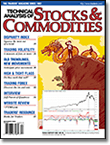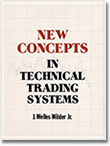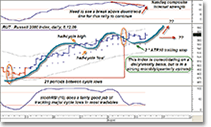Letters To The Editor
February 2010 Letters To The Editor
The editors of S&C invite readers to submit their opinions and information on subjects relating to technical analysis and this magazine. This column is our means of communication with our readers. Is there something you would like to know more (or less) about? Tell us about it. Without a source of new ideas and subjects coming from our readers, this magazine would not exist.
Address your correspondence to: Editor, Stocks & Commodities, 4757 California Ave. SW, Seattle, WA 98116-4499, or E-mail to editor@traders.com. All letters become the property of Technical Analysis, Inc. Letter-writers must include their full name and address for verification. Letters may be edited for length or clarity. The opinions expressed in this column do not necessarily represent those of the magazine. —Editor
TRADING FOREX
 Editor,
Editor,
I enjoyed Koos van der Merwe’s article on forex in the December 2009 Stocks & Commodities (“Trading Forex”). I was curious if he had any suggestions as to where I can get a good foundation in the fundamental side of forex that he discussed in the article. There are clearly numerous relationships that need to be understood. Any suggestions?
—Bill
Koos van der Merwe replies:
Forex is about currencies — that is, money used in everyday life. The only way to understand a currency from the fundamental side is to choose, say, two currencies that you are interested in, and then read as much as you can about the central banks that control those two currencies. Try to understand the thinking and tactics used by the governors of those central banks in managing the currencies.
For example, let’s look at the US dollar, which took over from gold as the foundation that world currencies base their strength or weakness on. At the moment, the US is printing more money than usual under the direction of Fed chairman Ben Bernanke. By doing so, he is creating money out of thin air to pay off debt. Milton Friedman, the famous economist, theorized that printing money to excess causes inflation. (I suggest buying a book on Milton Friedman and reading up on his theories.) In today’s world, we have seen this happen in Zimbabwe, where the paper used to print the money has become more valuable than the money itself! But my feeling is to trust Bernanke on this; he was a student of the 1930s Depression, and so far he has helped the US avoid a depression. However, will “Helicopter Ben” keep inflation at bay? I believe that’s Paul Volcker’s job. (As chairman of the Economic Recovery Advisory Board under President Barack Obama, he is the traffic cop keeping a close eye on Bernanke.) Why? I was around when Volcker solved the inflation problem of the 1980s, and I credit him with that.
As for where I get my facts and information from (the essence of your question), I read The Economist magazine, BusinessWeek magazine, Financial Times (British), The Wall Street Journal, and every newspaper I can find with a writer who seems to write sensibly about world currencies (there are many who don’t). Lately, I’ve been finding a great deal of news off my iPhone. You will soon learn to distinguish the wheat from the chaff.
Best of luck in your reading.
PARABOLIC SAR INDICATOR
Editor,
I have read some of your articles on the parabolic Sar indicator. Is there any good book that covers this indicator exclusively and also gives insight on how to use this indicator in conjunction with other tools and chart patterns? I have many books on trading, but information on the parabolic Sar is very limited with very few examples.
—Yagnesh Patel
London, UK
 The parabolic Sar was introduced in J. Welles Wilder’s classic 1978 book, New Concepts In Technical Trading Systems (Trend Research), so that should be in your library if it’s not already.
The parabolic Sar was introduced in J. Welles Wilder’s classic 1978 book, New Concepts In Technical Trading Systems (Trend Research), so that should be in your library if it’s not already.
The following are some articles we’ve published on the parabolic Sar. These and other articles are available from our online store at www.traders.com.
—Editor
Stay In The Market With Stop-And-Reverse (Working Money, April 2002)
If you hate being out of the market, you should take a look at this system. The parabolic time/price system indicator was developed by J. Welles Wilder. Often referred to as parabolic Sar or simply Sar (for “stop and reverse”), the term comes from its appearance as a parabola when viewed on a chart.
By Rudy Teseo
Parabolics (July 1997)
Here’s a look at the parabolic trading system, with details on the way it works and how it’s calculated.
By John Sweeney
Modifying The Parabolic Stop And Reversal (April 1995)
(with sidebar: “The Parabolic Trading System”)
The parabolic stop and reversal indicator is a popular trading tool, but it’s subject to false signals. Here’s how it can be modified to improve its performance.
By Dennis Meyers
The Parabolic Trading System (November 1993)
Traders are always searching for methods with which to manage risk through the use of stop-loss orders. One method that has been proposed for determining stops is by using a mechanical formula based on the parabolic indicator, also known as the stop and reverse (Sar). How does it work?
By Thom Hartle
Setting Stops: A New Approach (November 1989)
Skillfully selected exit points can often make a large difference between overall profit and loss. One commonly used exit strategy is J. Welles Wilder’s parabolic stop-and-reverse, or Sar.
By John Ehlers
CHART ANNOTATION SOFTWARE?
Editor,
Donald Pendergast, a frequent contributor to your online publications at your website, Traders.com, uses some kind of annotation software to mark his MetaStock charts with text, circles, arrows, and so on. Do you know what software package he uses to do this?
Thanks for your time.
—Russ Schmidt
Donald Pendergast replies:
I use Snagit (www.techsmith.com).
ARI KIEV, 1924–2009
Ari Kiev, who contributed a number of articles to Stocks & Commodities over the years since his first in 1994, passed away in November 2009 due to complications from cancer. The Bronx, NY–born psychiatrist wrote articles on how traders could improve their performance in the markets, which originally came about from his early work with athletes. His varied interests ranged from medicine to law to anthropology, and at the time of his death he was working on a master’s degree in executive health care. His books on Wall Street included Trading To Win, Trading In The Zone, and Hedge Fund Masters, and his last book, The Mental Strategies Of Top Traders, came out in December 2009 from John Wiley & Sons. He will be missed.

